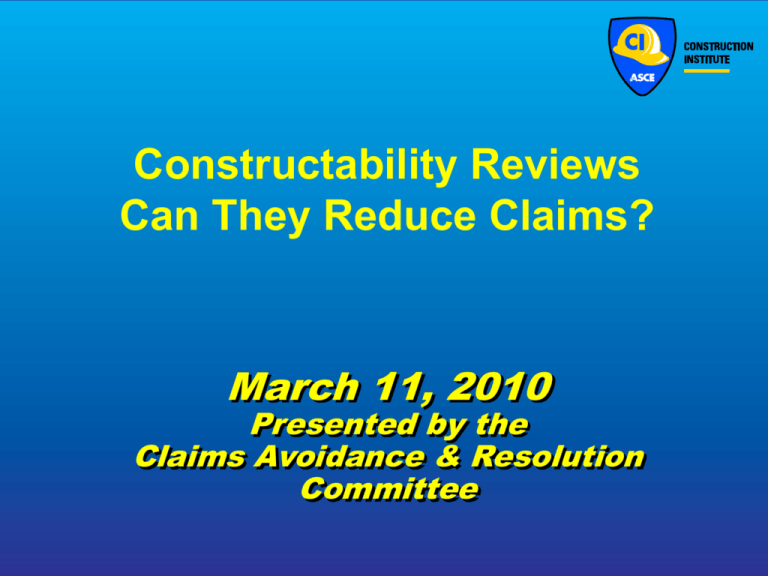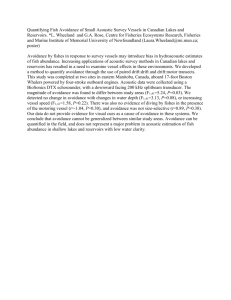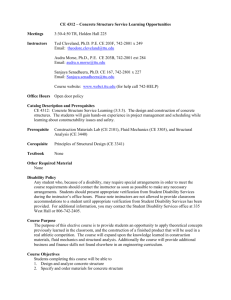Dispute Resolution Methods
advertisement

Constructability Reviews Can They Reduce Claims? March 11, 2010 Presented by the Claims Avoidance & Resolution Committee Prepared by Constructability Reviews Subcommittee •Rayford W. Jenkins, PE •Dan Becker, PMP, CCE •Philips Vallakalil, CCM •Bob Shoff, P.E. Construction Institute Claims Avoidance and Resolution Committee Constructability Reviews Constructability : The ease with which a project can be built, based upon the clarity, consistency, and completeness of the contract documents for bidding, administration, and interpretation to achieve overall project objectives. Construction Institute Claims Avoidance and Resolution Committee Constructability Reviews Presentation Goals •Provide recommended practices for use in performing constructability reviews. •Demonstrate the benefits of performing constructability reviews Construction Institute Claims Avoidance and Resolution Committee What is a Constructability Review? •Answers the Following Questions: • Can the Project Be Built, Using Industry Accepted • • Means and Methods, as Designed? Can the Project Be Bid Using the Information Provided in The Contract Documents? Can The Project Be Built in The Specified Timeframe, with the Specified Quality, with safe work practices? • Provides A Comprehensive QA/QC Check Construction Institute Claims Avoidance and Resolution Committee The Difference Between a Constructability Review and Value Engineering? Constructability Reviews Value Engineering Reviews • Performed by construction • Performed by construction professionals and engineers • Focuses on function over form/life cycle costs • Performed earlier in the design process to have the maximum benefit • • professionals experienced in constructing similar projects Performed throughout the design and construction document preparation process Focuses on inconsistencies in the contract/bid documents to reduce propensity for changes/claims Construction Institute Claims Avoidance and Resolution Committee Why Does Constructability Matter? •Better Quality •Reduced Risk •Reduced Cost Construction Institute Claims Avoidance and Resolution Committee Who Performs a Constructability Review •Internal Review •Outside Review By Consultant •Outside Review By Contractor Construction Institute Claims Avoidance and Resolution Committee Who should Perform Constructability Reviews • Performed by experienced construction specialists – Construction Managers/Resident Engineers – Construction Superintendents (working/retired) – Inspectors Construction Institute Claims Avoidance and Resolution Committee When to Perform Constructability Reviews? Construction Institute Claims Avoidance and Resolution Committee Constructability Reviews Performed At Key Design Milestones Will Benefit The Project •Planning Stage of The Project •30% Design •60% Design •100% Design Construction Institute Claims Avoidance and Resolution Committee Constructability Issues at The Planning Stage Does the concept address: •Timing •Phasing •Site accessibility •Budget and funding •Future operation and maintenance issues Construction Institute Claims Avoidance and Resolution Committee Constructability Issues at 30% Design More In-Depth Than Conceptual Plus The Following: •Identify any special construction required •Identify constraints •Identify responsibilities •Review preliminary schedule •Verify budget •Field visit to verify existing conditions Construction Institute Claims Avoidance and Resolution Committee Constructability Issues at 60% Design Local, Regional, Federal Regulatory Constraints Realistic Procurement and Fabrication Lead Times Labor Constraints Look For And Identify Conflicts Construction Institute Claims Avoidance and Resolution Committee Constructability Issues at 60% Design Conflicts between design disciplines Conflicts between plans Conflicts with adjacent projects Construction Institute Claims Avoidance and Resolution Committee Constructability Issues at 100% Design Do the Specifications and Plans Agree? Deficiencies in specifications, eg. Copied specs, expired specs, generic specs, impractical specs. General Conditions and Division 1 clauses are consistent with management strategy. Coordination between plans developed by different disciplines. Construction Institute Claims Avoidance and Resolution Committee Constructability Issues at 100% Design Ensure attention to the requirements of the public including adjacent land use functions, existing users or patrons, and persons with disabilities. Ensure coordination with operating elements of the existing owners' systems, if any. Construction Institute Claims Avoidance and Resolution Committee Constructability Issues at 100% Design Can a Contractor Prepare a Fair Bid From The Contract Documents? Construction Institute Claims Avoidance and Resolution Committee Constructability Issues at 100% Design Is The Schedule Reasonable? Is the Cost Estimate Complete, Reasonable and within budget? Construction Institute Claims Avoidance and Resolution Committee Reviewing The Schedule Availability and lead time for materials / equipment Availability and capabilities of local labor. Will the various trades have to work concurrently? Illogical and needlessly costly construction sequences. Construction Institute Claims Avoidance and Resolution Committee Reviewing The Schedule Shutdown durations and tie-ins for operation of existing facilities. Temporary arrangements to facilitate operation of existing facilities. Temporary use of permanent facilities (beneficial occupancy.) How well are these defined in the contract documents Construction Institute Claims Avoidance and Resolution Committee Constructability Review Results (Lessons Learned) “Re-used” Specifications: It’s common for designers to reuse specifications from previous projects. Make sure that the specs match the project conditions. Construction Institute Claims Avoidance and Resolution Committee Constructability Review Results (Lessons Learned) Design conflicts resulting in specifications that are needlessly difficult, and sometimes impossible to build. Concrete anchors that were designed and installed in inaccessible areas, Equipment that could not be reached by available access routes. Construction Institute Claims Avoidance and Resolution Committee Constructability Review Results (Lessons Learned) Coordination with Geotechnical Recommendations: Blanket statements about compliance with recommendations made in the referenced geotechnical reports in the structural general notes may be in conflict with the information provided in the earthwork specifications or structural drawings. Construction Institute Claims Avoidance and Resolution Committee Constructability Review Results (Lessons Learned) Subjective Notes: If you want to get an earful, ask that grouchy old field superintendent how he feels about drawings riddled with subjective phrases such as …“in an approved manner” or …”as needed”. Construction Institute Claims Avoidance and Resolution Committee Constructability Review Results (Lessons Learned) Unaddressed Site Conditions: Again, maybe the most important part of the constructability review. Site conditions can change dramatically from the time a project owner conducts a site survey or an architect initially visits the site to the time of bid. Construction Institute Claims Avoidance and Resolution Committee Constructability Review Results (Lessons Learned) Drainage During Phased Construction: Has drainage been addressed for each phase of construction. Has storm water management been addressed for the various phases? Permitting requirements? Construction Institute Claims Avoidance and Resolution Committee Constructability Review Results (Lessons Learned) Utilities: Who is responsible for utility connections and its connection charges. Who is responsible for utility charges during construction, and clarify the date from which the owner will be responsible for the utility charges. If utilities are being constructed or relocated by others has this work been coordinated in the documents and schedule? Construction Institute Claims Avoidance and Resolution Committee Constructability Review Results (Lessons Learned) Requirements for owner provided materials, equipment, services, and utility connections: Will the equipment be available when needed? Do the plans or specifications provide sufficient information about owner supplied equipment to allow the contractor to price the cost of installation? Construction Institute Claims Avoidance and Resolution Committee Constructability Reviews Can They Reduce Claims? YES! Construction Institute Claims Avoidance and Resolution Committee Questions? Construction Institute Claims Avoidance and Resolution Committee





